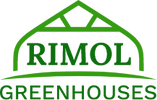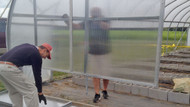Written by Karen Kritz (Agricultural Economic Development, NJ Department of Agriculture) and reprinted with permission, this is an excellent example of guidelines that may exist in your state. Check with your Department of Agriculture, local Farm Bureau, or State Trade Associations.
When designing a greenhouse, there are construction criteria that must be evaluated prior to making a final determination on the design. The size of the structure, type of construction material used, the greenhouse layout, intended production (wholesale vs. retail) and how the structure is erected will have implications on the permitting requirements and the final real property tax assessment on the structure.
Construction
New Jersey’s Uniform Construction Code (UCC) contains a provision that exempts temporary greenhouses from building subcode permit when the structure is a commercial farm building. The eligibility criteria that must be met in its entirety includes: solely used for the production or storage of live plants; no permanent anchoring system or foundation; no storage, temporary or otherwise, of solvents, fertilizers, gases or other chemicals or flammable materials; no wider than 31 feet and there is an unobstructed path of no greater length than 150 feet from any point to a door or fully accessible wall area; the covering of which is a material no greater than six mils (152.4 micrometers) in thickness that yields approximately four pounds of maximum impact resistance to provide egress through the wall; and the covering of the structure is of a material that conforms to NFPA 701. If the greenhouse does not meet all of the criteria, a construction permit must be secured.
When the greenhouse is a commercial farm building and necessitates a construction permit, other requirements include: all plans must be signed and sealed by a NJ licensed architect; all electrical work must be performed by a NJ licensed electrician; all plumbing work must be performed by a NJ licensed plumber; and permits must be secured for heaters and fans. Any building, including farm buildings, which require a municipal construction permit and which disturb more than 5,000 square feet of soil, is required to secure certification of a soil erosion and sediment control plan from the local Soil Conservation District (SCD). If the farmer’s farm conservation plan addresses the farm building construction, the conservation plan may be approved by the SCD.
Greenhouses used for retail sales do not qualify as commercial farm buildings. Structures that are used for display or sales purposes and accessible to the public including, among others, retail stores, shops and salesrooms and markets must be constructed according to Group M (Mercantile). Retail farm stands and markets are considered mercantile.
Real Property Taxation
By law, certain single-use agricultural or horticultural facilities are exempt from real property taxation. The statute goes on to specify that readily demountable greenhouses qualify as single-use agricultural or horticultural facilities. When the greenhouse is dismantled, it can be removed without damage to the structure or to the real property. However, the exempt greenhouse shall not include a structure that encloses a space within its walls used for housing, shelter, or working, office or sales space, whether or not removable.
The first matter to address is readily demountable. In order to be viewed as readily demountable, when designing the greenhouse, it is imperative that the structure is bolted together, not welded, so it can be disassembled without cutting any of the framework. The perimeter and interior vertical supports (ground poles) must be bolted to the pier foundation with the sleeve protruding from the pier. The vertical frame supports must then be bolted to the sleeves. Thus, when the framework is unbolted from the piers, the pier foundation can be easily pulled out of the ground. The purlins, bows, bracing, and framework and all parts of the structure must be bolted.
The second aspect that must be addressed is the greenhouse encompassing other uses—what else is enclosed in the greenhouse. If there is an area for the storage of equipment used in the growing and harvesting of the agricultural or horticultural commodity, the exemption is not compromised because the equipment is inherent and essential to growing the agricultural or horticultural commodity and does not compromise the ‘single use’ of the structure for growing the commodity. However, if the greenhouse encloses an office, working or sales space, then the greenhouse does not qualify for the exemption because they are used for functions not essential or inherent to growing the agricultural or horticultural commodity.
Zoning
Any questions on determining how a particular parcel of land is zoned and what activities are permissible in that zone should be directed to the municipal zoning official. If there is a dispute between the municipality and the farmer regarding zoning issues, the farmer may be eligible for protections of the Right to Farm Act. The farmer should contact his/her County Agriculture Development Board or the State Agriculture Development Committee (SADC) at (609) 984-2504 for assistance.
For Additional Information
UCC & Real Property Taxation
Karen Kritz, NJ Department of Agriculture
(609) 984-2506
karen.kritz@ag.state.nj.us
Soil Erosion & Sediment Control Plan
State Soil Conservation Committee
(609) 292-5540
Zoning
Right to Farm, SADC
(609) 984-2504

